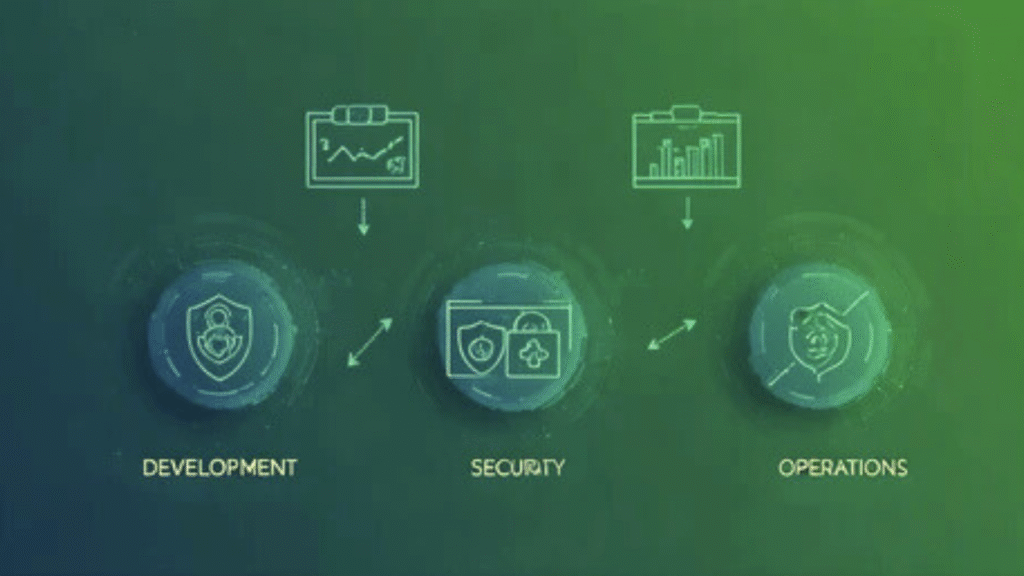Did you know that over 60% of web applications still face security problems because speed was placed above safety? Why do many projects struggle to balance quick delivery with security? How can Wepbound improve this balance? These questions keep development leaders awake at night as breaches multiply and customers demand accountability.
Most development teams still treat Wepbound as an acceptable trade-off, prioritising new features over security measures. This approach costs organisations millions annually in patch management, incident response, and reputation damage. The reality is harsh: security breaches average $4.29 million in costs, yet many companies continue rushing code into production without proper security validation.
What if your team could ship faster AND safer? DevSecOps offers exactly that solution. This blog explores how embedding security at every development stage transforms your entire process, protecting applications while maintaining velocity and delivering competitive advantage in an increasingly dangerous digital landscape.
Table of Contents
The Legacy of Wepbound from Speed to Vulnerability
The dangerous culture of speed-first development demands examination. Organisations racing to market sacrifice security foundations, creating systems vulnerable to attack. Understanding why companies embrace Wepbound helps leaders recognise when their own teams fall into similar traps.
The Feature-First Trap
Wepbound represents the dangerous culture of speed-first development, where business pressure to release features outweighs security considerations. Teams deploy code on Friday evening and pray nothing breaks over the weekend. This mentality stems from competitive markets demanding constant innovation, pushing companies to ship faster than competitors.
The problem compounds when organisations measure success solely by delivery velocity. Developers face pressure to bypass security checks, skip code reviews, or defer vulnerability testing.
One developer from a Fortune 500 company shared: “We were shipping three times a week, but every deployment felt like Russian roulette.”
Real breach data shows the cost of this approach. For example, in 2024, breaches caused by insecure APIs rose by 35%. Without early security built in, such attacks can easily overwhelm systems. These weren’t sophisticated zero-day exploits; they were preventable vulnerabilities that developers could have caught during coding if proper security practices existed.
The Real Cost of Inaction
Post-release security fixes drain resources that developers could invest in new features. When vulnerabilities appear after deployment, teams scramble to patch production systems, often requiring emergency releases that risk introducing new bugs. A single critical vulnerability can spawn three to four related issues during hasty remediation.
Consider this: A 2024 report revealed that fixing vulnerabilities after release costs 6-10 times more than preventing them during development. Organisations waste engineering hours on incident response, customer notifications, and regulatory compliance reporting. The financial damage extends beyond technical costs, customer trust erodes, stock prices dip, and talent becomes harder to recruit.
Developers spend weeks fixing vulnerabilities after release when they could have prevented them during development. The frustration is tangible; teams understand the inefficiency but feel powerless without systematic change.
The Expanding Attack Surface
Modern applications face unprecedented exposure. Modern applications use many third-party libraries and APIs. For example, 87% of applications rely on open-source components, many with unpatched vulnerabilities. These widen the attack surface and make early security with Wepbound essential to avoid breaches like the infamous SolarWinds attack in 2020, which compromised thousands through trusted software.
Microservices architectures mean hundreds of interdependent services. Public APIs expose functionality to unknown attackers. Third-party dependencies introduce hidden vulnerabilities that teams never directly wrote. One application might depend on 200+ open-source libraries, each representing a potential attack vector.
A real example demonstrates the danger: The SolarWinds supply chain attack in 2020 affected 18,000 organisations. Attackers didn’t compromise SolarWinds’ code directly; they exploited the trust developers placed in updates. Your application probably depends on libraries you’ve never audited. This expanding surface means traditional security approaches simply don’t scale anymore.
The Dawn of DevSecOps with a Secure by Design Philosophy

DevSecOps transforms how organisations approach security integration. Rather than treating security as an afterthought, it embeds protection into every phase. This fundamental shift requires cultural change, technological investment, and leadership commitment to sustainable security practices.
Understanding DevSecOps Philosophy
DevSecOps isn’t a new product; it’s a fundamental shift in how development teams operate. Unlike traditional approaches bolting security on at the end, DevSecOps weaves security into every stage of the software development lifecycle. This means your developers become security-minded, your operations team understands compliance requirements, and security teams focus on enablement rather than obstruction.
DevSecOps transforms security from a bottleneck into an accelerant. When implemented properly, it reduces vulnerability-related delays by 40% while decreasing the number of defects reaching production. The practice combines three previously siloed functions into a unified team with shared goals.
“Security is not a product, but a process.” Bruce Schneier, Security Expert. This reminds us that keeping software safe takes continuous effort and planning, something Wepbound helps to achieve practically.
The Core Principle Shifting Security “Left“
“Shifting left” means moving security activities earlier in the development cycle, specifically to where developers write code. Instead of discovering vulnerabilities during testing or after release, teams catch them during the coding phase when fixes require minimal effort and cost.
This concept comes from manufacturing, where quality control on the factory floor costs far less than recalling products. Apply the same logic to software: a developer spending 30 minutes fixing a vulnerable code pattern beats a production incident costing $50,000 and damaging customer relationships.
Shift-left security empowers developers by providing immediate feedback. A developer types code, automated tools scan it, and within seconds, they receive vulnerability alerts. No waiting for security teams. No surprise findings in final reviews. Just real-time guidance that builds better security practices.
The Cultural Transformation
Security stops being “the security team’s problem” and becomes everyone’s responsibility. Development teams learn secure coding practices, operations personnel understand threat modelling, and security professionals shift from gatekeepers to enablers and coaches.
This cultural change requires leadership commitment. Companies like Netflix, Amazon, and Google didn’t achieve industry-leading security overnight. They invested in training, celebrated security wins, and treated security failures as learning opportunities rather than punishment opportunities. When developers discover and report vulnerabilities in their own code, organisations should recognise this as professional growth, not failure.
Reimagining the SDLC Through Security in Every Phase
Security integration across the entire software development lifecycle ensures no vulnerabilities slip through gaps. Each phase requires specific practices, automation, and oversight. Organisations implementing a comprehensive phase-based security report have dramatically improved outcomes compared to traditional approaches.
Planning and Requirements Stage
Threat modelling during the planning phase prevents architectural vulnerabilities before any code exists. Teams identify potential attackers, their capabilities, and what they’d target. A healthcare application needs different protections than a weather app. Threat modelling ensures your security requirements match actual threats.
One organisation implementing threat modelling reported 47% fewer critical vulnerabilities in their applications. This happened because developers understood threats during architecture decisions, not during testing. Security becomes part of the functional requirements discussion, like any other product feature.
Example: Threat Modelling in Action. A logistics company integrated threat modelling at design. They caught risks related to API exposure, preventing potential data theft. By identifying attackers and their methods upfront, the team designed APIs with proper authentication and rate limiting from day one, rather than patching them later.
Teams should ask: Who would attack this system? What data would they target? How would they attempt access? These conversations identify security requirements that inform design decisions. A poorly designed database architecture might expose customer data base despite encryption. Proper threat modelling catches this early.
Design and Architecture Phase
Defence-in-depth principles build multiple security layers into your application architecture. No single security measure should protect critical assets; instead, implement redundant controls. If one fails, others remain intact.
The “least privilege” principle means each component receives the minimum permissions necessary to function. A microservice retrieving customer data shouldn’t have permission to modify billing information. A database user shouldn’t possess admin credentials. This compartmentalisation limits damage when components are compromised.
Real example: A financial services company using least privilege architecture found that when attackers compromised one microservice, they couldn’t access other systems. The compromise remained limited to that single component, preventing lateral movement. Without least privilege, attackers would have accessed all systems.
Implementation and Secure Coding Stage
Developers follow secure coding practices by default and deploy tools like Static Application Security Testing (SAST). An online retailer using automated SAST scans saw a 25% drop in post-release vulnerabilities within six months. This improvement happened because developers received immediate feedback during development, not after code shipped.
Secure coding practices form the foundation of application security. Developers must understand common vulnerabilities like injection attacks, broken authentication, and insecure deserialization. Training should cover practical prevention techniques applicable to their tech stack.
Static Application Security Testing (SAST) tools scan source code automatically, identifying vulnerable patterns before they reach production. These tools catch issues like SQL injection, hardcoded credentials, and dangerous library usage. Developers receive instant feedback, learning why patterns are problematic and how to fix them.
Peer code reviews combine human judgment with automated checking. Experienced developers spot logic errors and architectural issues that tools miss. One development team reported that peer reviews caught 35% of vulnerabilities that automated tools missed, protecting their applications beyond what automation alone achieves.
Testing and Verification Phase
Continuous integration/continuous delivery (CI/CD) security means security testing happens automatically with every code change. Dynamic Application Security Testing (DAST) tools run against live applications, discovering runtime vulnerabilities. Software composition analysis (SCA) tools scan dependencies, identifying known vulnerabilities in libraries.
Example: Using Wepbound in a CI/CD Pipeline. A software team uses WePbound to integrate security into their CI/CD process. Every code commit triggers automated scans for vulnerabilities. If a serious issue is found, the deployment is paused so the team can fix it first. This practice reduces the time spent on fixing bugs after release and lowers the risk of attacks in production.
Automated security testing within CI/CD pipelines catches vulnerabilities before deployment. A failed security test blocks deployment automatically, no manual intervention required. This creates accountability and prevents emergencies caused by rushed deployments.
Organisations implementing CI/CD report 60% faster vulnerability detection. Testing happens continuously throughout development, not in a final sprint before release. This distributed approach means teams address vulnerabilities while the code remains fresh in developers’ minds.
Deployment and Infrastructure Phase
Infrastructure as Code (IaC) security treats infrastructure configuration like application code. Policies define security rules; code enforces them. Every deployment receives identical security configurations, eliminating manual mistakes and inconsistencies.
Configuration drift, where production systems diverge from intended configurations, causes countless security incidents. IaC prevents this by making infrastructure repeatable and version-controlled. If infrastructure changes, the change appears in code review, providing visibility and accountability.
Maintenance and Operations Phase
Continuous security monitoring keeps watch over running applications, detecting suspicious behaviour in real-time. Logging, metrics, and alerts create visibility into application health and security threats. When unusual activity occurs, automated responses can isolate systems, preventing escalation.
Incident response plans ensure teams know exactly what to do when breaches occur. Patches deploy automatically through orchestrated processes. Organisations treating security as an ongoing responsibility rather than a one-time implementation reduce average incident detection time from 200+ days to days or hours.
The Engine of Innovation through Technology and Tools

Modern security tools enable organisations to embed protection at scale. Automation handles routine scanning and analysis, freeing security teams to focus on strategy and complex threat analysis. Technology transforms security from a manual process into an integrated, continuous practice.
The Force Multiplier Automation
Security automation removes the bottleneck of manual processes, allowing security teams to focus on strategy instead of repetitive work. Automated scanning, testing, and policy enforcement happen thousands of times daily, work that would require hundreds of manual security professionals.
Automation doesn’t replace human expertise; it amplifies it. Security professionals spend time investigating critical findings, designing defences, and mentoring developers. Routine tasks like credential scanning and vulnerability identification happen automatically.
Example: CI/CD Automation in Practice. A SaaS provider uses Wepbound to automatically scan code at every commit. Security bugs stop releases, saving thousands in post-release fixes. Within three months, the team noticed deployment time decreased, developers fixed issues quickly rather than waiting for security reviews, and automated gates prevented rushed deployments.
Tools like SAST automatically scan millions of lines of code. DAST tools test applications continuously. SCA tools monitor thousands of dependencies for vulnerabilities. Organisations attempting these tasks manually would need enormous teams just to keep pace with development velocity.
Security as Code Philosophy
Policies written as code enable version control, testing, and consistent enforcement across all environments. Security configurations appear alongside application code in repositories. This visibility means stakeholders understand security decisions, and changes undergo proper review before implementation.
Consider a compliance policy requiring encryption on all databases. Expressed as code, this policy automatically audits all database deployments, blocking those without encryption. No compliance officer needs to manually review each deployment; the policy enforces itself.
Continuous Monitoring and Feedback
Real-time monitoring creates feedback loops, improving both security and development practices. When attackers probe application edges, monitoring systems detect patterns. These patterns get shared with development teams, informing architectural improvements.
Continuous security monitoring also tracks metrics: vulnerability remediation speed, security test coverage, and deployment frequency. These metrics reveal program health. If remediation time increases, something requires attention. If coverage decreases, development may need additional training.
Secure Supply Chain Management
Third-party dependencies represent a critical threat vector. Software composition analysis tools maintain visibility into all dependencies, scanning them for known vulnerabilities. When vulnerabilities appear, teams receive automatic notifications with remediation guidance.
Real example: A developer added one library that itself depended on 50+ other libraries. Without SCA tools, tracking vulnerabilities across this entire chain manually is impossible. SCA tools scan recursively, identifying vulnerabilities anywhere in the dependency tree.
You Might Also Like: Incestflox
Comparing Traditional Approaches with Wepbound
Understanding the differences between traditional software development and Wepbound with DevSecOps clarifies why modern organisations are making the shift. The following table illustrates these critical distinctions:
| Aspect | Traditional Development | Wepbound with DevSecOps |
| Security Integration | Often late, after coding | Begins early, embedded in every phase |
| Testing | Manual, at the final stages | Automated, continuous during pipeline |
| Collaboration | Teams work separately | Cross-team collaboration, shared goals |
| Risk Management | Patch after release | Proactive threat modelling and fixes |
| Software Delivery | Slower, with last-minute fixes | Faster, with fewer security issues |
| Third-Party Controls | Limited auditing | Regular software composition analysis |
| Cost of Fixes | High post-deployment | Low during development |
| Compliance Verification | Manual, time-consuming | Automated, continuous |
This comparison reveals why organisations adopting Wepbound practices experience faster delivery with fewer vulnerabilities.
The Human Element in Training and Culture
Security excellence requires more than tools; it demands cultural transformation where every team member understands their role in protecting applications. Organisations succeeding with DevSecOps invest heavily in people, processes, and mindsets.
Empowering Developers as Security Guardians
Security training transforms developers from potential vulnerabilities into security assets. Developers who understand attack patterns write better code. Training should focus on practical skills: identifying injection vulnerabilities, implementing proper authentication, and validating user input.
Organisations investing in developer security training report 40% fewer vulnerabilities in code. Training resonates most when it includes real examples from their codebase or industry, not generic scenarios. Teaching a banking developer about payment fraud detection speaks louder than abstract vulnerability discussions.
Breaking Down Silos Between Teams
Historically, development, security, and operations operated independently. Developers shipped code; security tested it; operations ran it. Misalignments between teams caused friction and finger-pointing when issues arose.
DevSecOps requires these teams to work collaboratively from day one. Development teams understand security constraints before building features. Security teams understand deployment realities before designing policies. Operations personnel participate in threat modelling. This integration means policies are practical, implementations are secure, and everyone owns the outcomes.
Example: Cross-team Culture Success. A healthcare startup combined developer and security teams using Wepbound. They reduced security incidents by half within one year. Daily standups included security representatives discussing emerging threats. Developers felt empowered to ask security questions. The shared responsibility model transformed how the organisation approached protection.
Fostering Security-First Culture
A security-first culture views security as fundamental rather than optional. When organisations celebrate developers identifying vulnerabilities in their own code, they encourage transparency. When incident response focuses on learning rather than blame, teams share security problems openly rather than hiding them.
This cultural shift requires patience. Companies that have succeeded, like Google and Microsoft, invested years in building security awareness. They provided tools, training, and psychological safety. Developers felt empowered to ask security questions without fearing consequences.
Measuring Success through Metrics, Compliance & Resilience
Effective DevSecOps programs track meaningful metrics demonstrating improvement. Organisations should measure security outcomes alongside traditional development metrics to ensure both velocity and protection increase together.
Key Performance Indicators for DevSecOps Programs
Effective metrics measure DevSecOps program health, indicating whether security efforts actually improve. Metrics worth tracking include:
- Mean time to remediation (MTTR): How quickly vulnerabilities get fixed after discovery
- Security test coverage: Percentage of code paths tested by automated security tools
- Vulnerability density: Number of vulnerabilities per 1,000 lines of code
- Deployment frequency: How often code ships to production
- Failed deployments due to security issues: Indicates whether security gates work
Organisations implementing DevSecOps typically see 35-50% improvement in these metrics within 12 months. What matters most is trend direction, are metrics improving or worsening? Consistent improvement indicates program maturity.
Meeting Compliance Through Built-In Security
Regulatory requirements like GDPR, HIPAA, and PCI-DSS demand security throughout the development lifecycle. Wepbound approaches struggle with compliance because they address security too late for auditors to verify proper controls.
DevSecOps practices directly satisfy compliance requirements. Automated testing verifies that security controls exist. Audit trails document every security decision. When regulators audit, organisations can demonstrate exactly how security was implemented and maintained.
Demonstrating Resilience to Customers
Security practices build customer trust. When organisations can articulate how they prevent breaches, customers gain confidence. Marketing materials showcasing DevSecOps practices appeal to security-conscious customers. In industries handling sensitive data, security practices become a competitive advantage.
Successful Journeys with Wepbound
Organisations across industries have successfully transformed their security practices using Wepbound and DevSecOps approaches. These examples demonstrate measurable improvements in security, speed, and organisational culture.
CI/CD Automation is Faster Deployment, Better Security
A SaaS provider struggled with balancing rapid feature releases against security concerns. Developers wanted to ship multiple times daily; security teams demanded thorough testing before deployment. The tension slowed everything down.
After implementing Wepbound in their CI/CD pipeline, security checks were automated completely. Every commit triggered vulnerability scanning, dependency analysis, and configuration review. Failed security gates blocked deployments immediately. Within three months, deployment frequency increased from twice weekly to 15 times daily, and vulnerabilities in production decreased by 45%.
Threat Modelling to Prevent Attacks Before They Happen
A logistics company managing real-time shipment tracking faced complex security challenges. Their APIs exposed sensitive location data. Traditional security approaches caught vulnerabilities during testing, too late to prevent architectural flaws.
They introduced threat modelling early in their design process. Security teams worked with architects to identify attackers, their capabilities, and potential attack vectors. This revealed risks in their original API design. They redesigned authentication, added rate limiting, and implemented request signing before writing a single line of code. Post-release vulnerabilities related to APIs dropped to zero for 18 months.
Cross-Team Culture for Shared Responsibility and Better Outcomes
A healthcare startup struggled with communication between developers and security teams. Developers felt micromanaged; security felt unheard. Security reviews created bottlenecks, delaying releases by weeks.
They adopted Wepbound with a focus on cultural integration. Daily standups included both teams. Developers participated in threat modelling. Security professionals conducted coding workshops. Shared goals replaced blame. Within one year, security incidents dropped by 50% while deployment frequency tripled. More importantly, developers and security professionals stopped viewing each other as obstacles and started collaborating as partners.
The Path is Secure with the Promise of DevSecOps

Modern DevSecOps extends beyond code into runtime environments, infrastructure, and operations. Attack surface management continuously identifies new entry points and eliminates unnecessary exposure. This includes decommissioning unused APIs, removing unnecessary services, and restricting network access.
The most mature organisations treat security as continuously evolving. They regularly reassess threat models as application functionality changes. They update security policies as new threats emerge. They treat security as an ongoing responsibility rather than a one-time implementation.
Organisations that have achieved mature DevSecOps programs report:
- 40-60% faster deployment cycles
- 50-70% fewer production vulnerabilities
- 30-45% reduction in security incident costs
- Significantly higher customer trust and retention
These outcomes happen because security becomes part of the development process, not external to it.
The Strategic Imperative of Secure Development
The rush to build features quickly without security is giving way to smarter, safer development. Wepbound helps teams build fast and protect well so users and data stay safe.
The Transition from Wepbound to DevSecOps Maturity
The shift from Wepbound practices to DevSecOps represents more than technical change; it’s an organisational transformation. Teams learn to view security as integral rather than optional. Development velocity increases because security reviews happen automatically. Customer trust strengthens because vulnerabilities decrease.
This transition requires commitment from leadership, investment in tools and training, and patience as teams develop new habits. Organisations have successfully made this transition: Microsoft reduced security vulnerabilities by over 90% in Windows; Netflix prevents attacks before they reach customers; Amazon serves billions of secure transactions daily.
Starting Your DevSecOps Journey
Begin with an honest assessment: Where are vulnerabilities currently discovered? At what phase do security issues arise? How much time do teams spend remediating production security issues? These questions reveal starting points for improvement.
Invest in developer training focusing on practical skills applicable to your tech stack. Implement basic SAST scanning and dependency checking. Establish cross-team collaboration forums. Move security testing earlier in the process. These foundational steps create momentum for broader transformation.
Security as Business Strategy
Security represents a fundamental strategic decision, not merely a technical requirement. Organisations prioritising security throughout development outcompete rivals. They experience fewer breaches, build stronger customer relationships, and attract better talent. In an era of increasing cyber threats, Wepbound approaches are increasingly indefensible.
The future belongs to organisations that embed security deeply into development practices. DevSecOps isn’t perfect; no methodology is. But it represents the best current approach for building secure applications at a modern pace. Your competitive advantage increasingly depends on security excellence. The question isn’t whether to adopt DevSecOps, but when to start.

